January 3, 2022 | History
The Origins of Crab Louis, the NW’s Quintessential Salad
Story by Knute Berger & Stephen Hegg of Mossback’s Northwest
Episode: Cracking the Case of Crab Louis
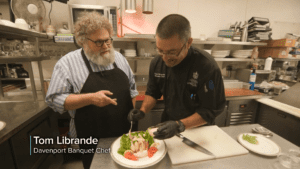
Mossback’s Northwest: Cracking the Case of Crab Louis
Washington state’s unofficial theme song is “Louie, Louie” — the early 1960s rock hit made famous by the Kingsmen and many Northwest bands. The lyrics they sang were almost unintelligible.
But something else is also hard to figure out: Who invented the Northwest seafood salad that everyone loves? Who invented crab Louis—or should it be crab Louie Louie?
The origins of crab Louis turn out to be muddy. It is widely served all over the country — it was very popular and considered a kind of cocktail era luxury for those who eschewed big steaks. It was served in seafood diners and fancy hotels.
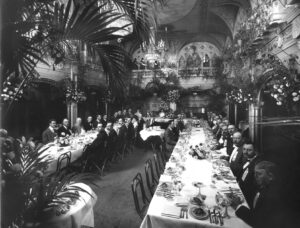
Guests dine at the Davenport Hotel
The salad’s origins appear to have been on the West Coast. That makes sense because in the late 19th century, we had an abundance of fresh crab. San Francisco, Seattle, Vancouver, and Portland served crab on menus dating back to the 19th century. We had a secret weapon: the Dungeness crab.
Capt. George Vancouver named Dungeness Spit, near what’s now the town of Sequim in Washington, because it reminded him of Dungeness back in England. When he and his expedition landed at nearby Discovery Bay in 1792, they hauled in fish and crab for the crew. What the Dungeness Spit area had was an abundance of sweet, tasty crab that was the best eating. Dungeness crab thrived from Northern California to Alaska. It became a commercial hit.
And as access to fresh crab expanded in the late 19th century with rail refrigeration and road systems to spread it around, more and more people could eat fresh crab without fear of food poisoning. Bad crab could kill, a fact newspaper stories widely advertised.
Fresh produce became more widely available, too — lettuce, for instance. In the 1800s, a crab salad might be crab — fresh or canned — mixed with mayonnaise. But in the early 20th century, crab with lettuce and other veggies and ingredients was a splendid novelty for the swells. Healthy, too. By the 1930s, crab Louis had become very popular in Seattle. An article in the Seattle Post-Intelligencer back then declared, “A trip to Seattle without a feast of crab a la Louis is like Paris without the Eiffel Tower.”
So, what was crab Louis?
Its first appearance in a Northwest cookbook dates to 1912 in the Portland Council of Jewish Women’s Neighborhood Cookbook. It calls for lettuce, two hard-boiled eggs and shredded crab meat. But the key was the Louis dressing — in this case, 3 tablespoons of oil, 1 of vinegar, ½ of catsup, 2 teaspoons Worcestershire sauce, paprika, salt, and a tad of English mustard. Mix and serve on lettuce leaves.
That’s a fancy meal that’s not hard to prepare — especially if you have the best crab in town. The key part is the dressing, not just plain mayo, but a zesty and often pink concoction.
The origins of Louis are disputed — success has a thousand fathers and mothers. One version says Italian tenor Enrico Caruso came to Seattle in 1904 and ate crab Louis at the Olympic Club or Olympic Hotel and developed an insatiable appetite for it. The only problem with that story is that the inimitable Caruso never performed in Seattle, though he was going to be invited to open the Moore Theater, which, alas, wasn’t finished in time for him to accept. He was in San Francisco, however, during the city’s 1906 earthquake, which he fled, unharmed.
San Francisco was an early adopter of Louis. The old French Poodle Dog restaurant in 1908 is said to have named Louis dressing after its chef, Louis Coutard. The restaurant was also decorated in Louis XIV style; perhaps that was a reference, too. The Coutard dressing lacks the familiar catsup, but includes Dijon mustard, champagne vinegar, chives, olive oil, tarragon and shallots. Another San Francisco restaurant, Solari’s, also laid claim to inventing crab Louis.
Famed chef James Beard grew up eating Crab Louis in Portland, his hometown. He said he first encountered it at a fine dining establishment called the Bohemian. Portland, he believed, was the origin of Louis dressing. In the 1920s, the Bohemian boasted of its “famous crab Louis” and in the ’30s advertised it on the radio.
Beard re-created the Bohemian’s recipe in the 1980s, saying, “The dressing is what makes the dish.” His modernized version called for homemade mayo and an equal part yogurt, chili sauce, grated onion, a dash of Tabasco sauce and some whipped cream. Oh, and as much crab as your generosity could afford. The yogurt was a nod to slimming down crab Louis calories, but it was rather offset by the whipped cream.
Louis is still a signature dish for some establishments — even ones far removed from the coast.
At the grand Davenport Hotel in Spokane, for example. It appeared on the menu the year the hotel opened in 1914 and is there still, named, it is said, for the hotel’s owner, Llewellyn “Louis” Davenport. The hotel’s salad includes fresh Dungeness crab, ripe tomato and lemon wedges, seeded cucumber and hard-boiled eggs. It won’t say what is in the Louis dressing. Put all that together, chill, and serve.
In the Northwest, for the last century at least, it’s always Louis Louis time.
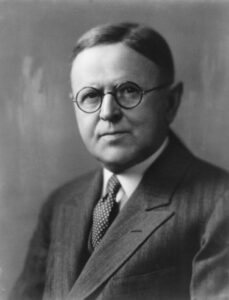
Louis Davenport
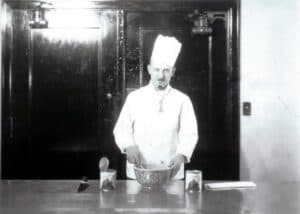
Davenport Chef Edward Mathieu, creator of the Davenport Hotel Crab Louis Salad, named after Louis Davenport
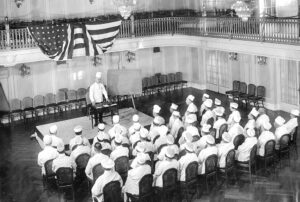
Chef Mathieu speaks to 1922 Davenport culinary team
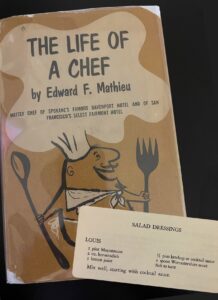
Chef Mathieu’s Memoir, which includes his famous Louis Dressing Recipe

Knute Berger of Mossback’s Northwest enjoys a Davenport Crab Louis Salad
Story by Knute Berger & Stephen Hegg of Mossback’s Northwest
Episode: Cracking the Case of Crab Louis
Recent Posts
Afternoon Tea at the Historic Davenport Hotel
Toasting Local Legacy: Davenport Hotel + Dry Fly Distilling
Weddings at the historic Davenport Hotel: A Love Story Steeped in Elegance
Holidays at the Davenport Hotel: A Spokane Tradition Like No Other
